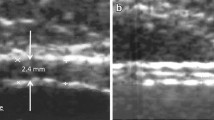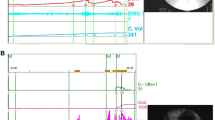Abstract.
Detrusor wall thickness decreases continuously while the bladder fills to 50% of its capacity and then remains constant until 100%. Therefore, detrusor wall measurements were performed in patients when the bladder was filled to maximum capacity only. Mean detrusor wall thickness for unobstructed (n=14), equivocal (n=23) and obstructed patients (n=33) were 1.33, 1.62 and 2.4 mm, respectively (P<0.001). With increasing CHESS letters and CHESS numbers, the thickness of the detrusor wall increased as well (P<0.001). The positive predictive value of detrusor wall measurement (95.5% for a cut-off value greater than or equal to 2 mm) was superior to all other predictors investigated. The thickness of the detrusor wall increases depending on the extent of BOO. Both constrictive and compressive BOO lead to an increase in detrusor wall thickness. BOO is found in 95.5% of men with a detrusor wall thickness greater than or equal to 2 mm. Measuring the thickness of the detrusor wall can be used as a screening test to detect BOO.
Similar content being viewed by others
Author information
Authors and Affiliations
Additional information
Electronic Publication
Rights and permissions
About this article
Cite this article
Oelke, M., Höfner, K., Wiese, B. et al. Increase in detrusor wall thickness indicates bladder outlet obstruction (BOO) in men. World J Urol 19, 443–452 (2002). https://doi.org/10.1007/s00345-001-0238-z
Published:
Issue Date:
DOI: https://doi.org/10.1007/s00345-001-0238-z




